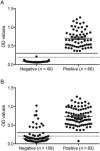Detection of antibodies against porcine epidemic diarrhea virus in serum and colostrum by indirect ELISA
- PMID: 25135339
- PMCID: PMC7110509
- DOI: 10.1016/j.tvjl.2014.07.018
Detection of antibodies against porcine epidemic diarrhea virus in serum and colostrum by indirect ELISA
Abstract
An indirect porcine epidemic diarrhea virus (PEDV) anti-immunoglobulin (Ig) G ELISA based on the S1 portion of the spike protein was validated and compared with an indirect immunofluorescence assay. In serum samples from experimentally infected pigs (n = 35), anti-IgG PEDV antibodies were detected as early as 7 days post-infection. In field serum samples (n = 239), the diagnostic sensitivity of the S1 ELISA was 100% and the diagnostic specificity was 94%. The S1 ELISA showed no cross-reactivity with antibodies against other porcine coronaviruses. Colostrum samples (n = 133) were also tested for anti-PEDV IgG and IgA. The diagnostic sensitivity was 92% for IgG and 100% for IgA, and the diagnostic specificity was 90% for IgG and 99.4% for IgA. These data suggest that the S1 ELISA is a sensitive and specific test that could also be used to evaluate PEDV colostral immunity.
Keywords: Diagnosis; ELISA; Porcine epidemic diarrhea virus; S1 protein; Serology.
Copyright © 2014 Elsevier Ltd. All rights reserved.
Figures




References
-
- Carvajal A., Lanza I., Diego R., Rubio P., Carmenes P. Evaluation of a blocking ELISA using monoclonal antibodies for the detection of porcine epidemic diarrhea virus and its antibodies. Journal of Veterinary Diagnostic Investigation. 1995;7:60–64. - PubMed
-
- Ha G.W., Kang B.K., Park S.J., Lee C.S., Oh J.S., Chai Y.G., Moon H.J., Park B.K., Song D.S. The colostral IgA level, but not the serum neutralization titer induced by immunization against porcine epidemic diarrhea virus is correlated with protection of new born piglets against virulent PEDV challenge. Korean Journal of Veterinary Public Health. 2010;34:53–58.
MeSH terms
Substances
LinkOut - more resources
Full Text Sources
Other Literature Sources
Miscellaneous

